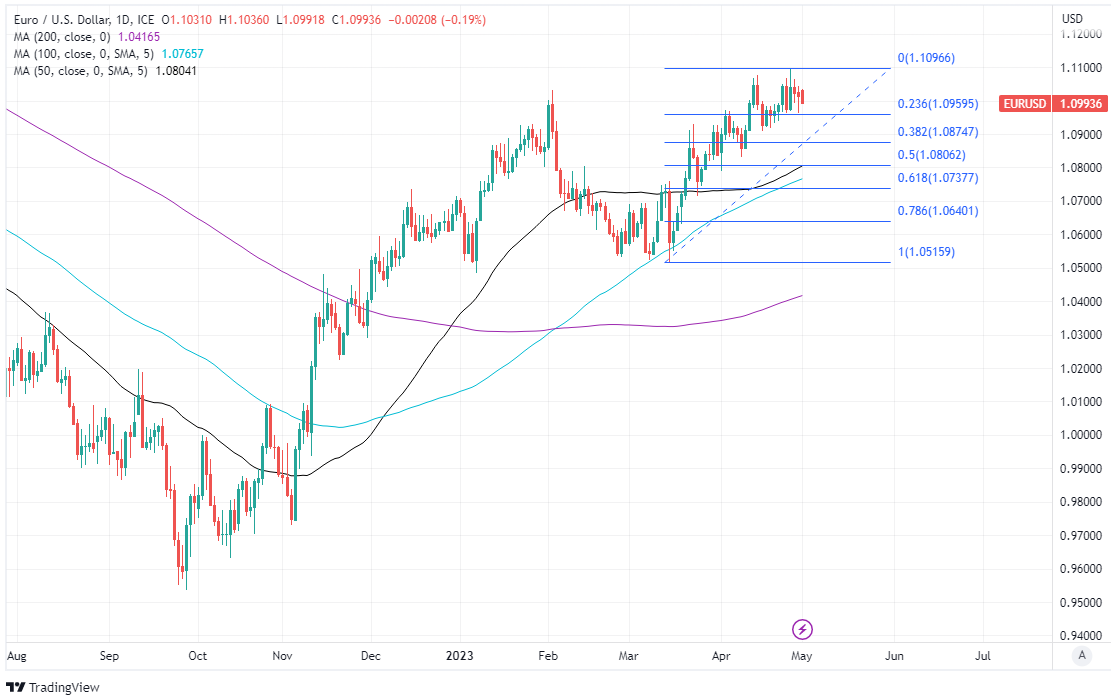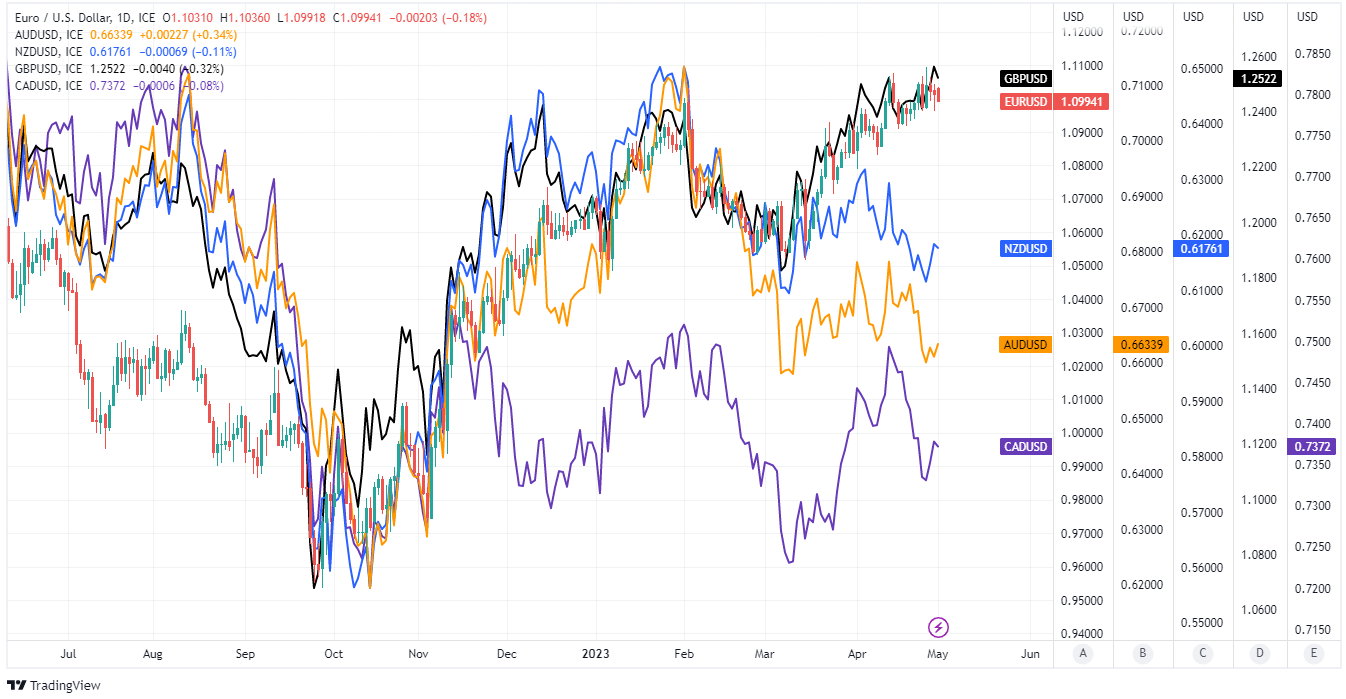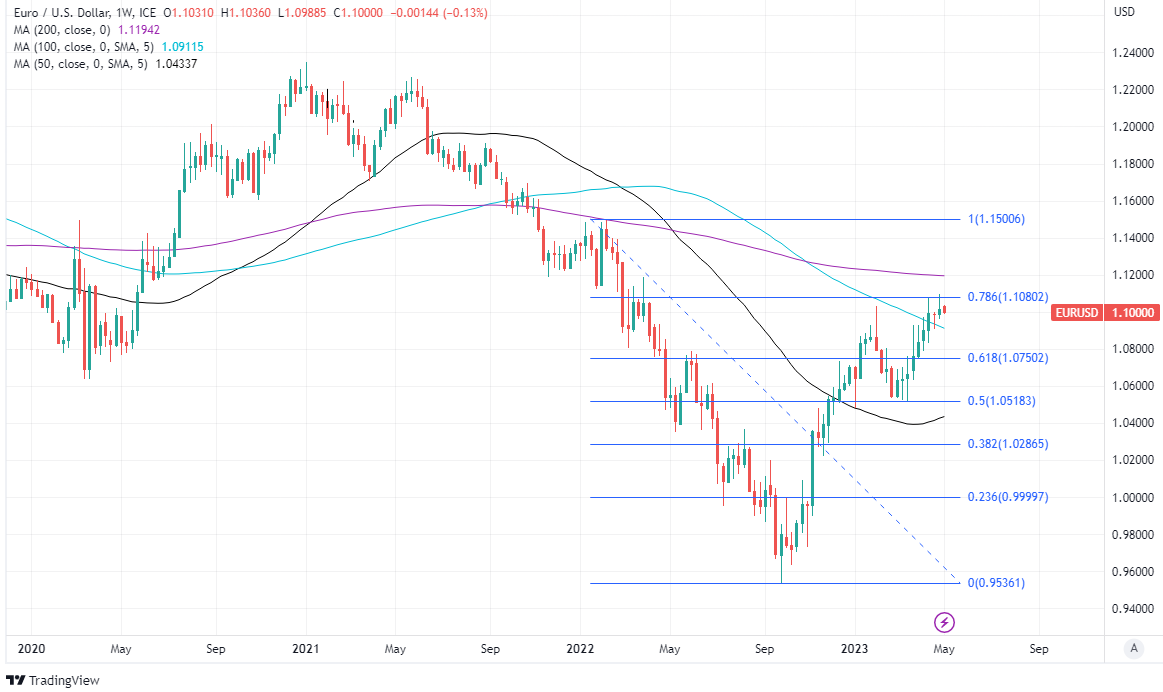EUR/USD Week Ahead Forecast: Eyes Further Gains but Risks Setback
- Written by: James Skinner
- EUR/USD procrastinates at 1.10 as outlook hangs in balance
- Supported near 1.0959, 1.0874 & 1.0806 on charts short-term
- Technical resistances obstruct recovery near 1.1080 & 1.1194
- Euro Area inflation, ECB rate outlook & Fed decision in focus

Image © Alfred Yaghobzadeh, European Commission Audiovisual Services
The Euro to Dollar exchange rate entered the new month procrastinating around the 1.10 handle but would likely struggle to sustain itself above that level unless this week's central bank policy decisions provide the single currency with a clearer interest rate advantage over the greenback.
Europe's single currency was among the best performers in the major currency basket for the week to Monday even after softer economic figures from some of Europe's major economies left the Euro lagging behind many continental counterparts ahead of the weekend.
"The GDP print for Q1 showed that PMI surveys have been quite misleading in predicting actual economic activity while national and EC surveys have been a better indicator of near-term growth," writes Sylvia Ardagne, chief Europe economist at Barclays, in a Friday research briefing.
"Confidence in industry has been on a downward path over the past year, while it has slowly improved in services but remained at levels consistent with only modest growth. This supports our projection of another quarter of mild growth in Q2 (+0.1% q/q) followed by stagnation in H2," she adds.
Eurostat figures suggested on Friday that European economic growth stalled in overall terms during the opening quarter, somewhat dispelling the optimism about the outlook that had been encouraged by private sector surveys released over the course of March and April.
 Above: Euro to Dollar rate shown at daily intervals alongside spread or gap between 02-year German and U.S. government bonds, with selected moving averages and Fibonacci retracements of March rally indicating possible areas of technical support for the single currency.
Above: Euro to Dollar rate shown at daily intervals alongside spread or gap between 02-year German and U.S. government bonds, with selected moving averages and Fibonacci retracements of March rally indicating possible areas of technical support for the single currency.
German GDP was unchanged in the opening quarter while French economic output edged higher in line with economic expectations following softness in consumer spending during the last leg of the period, somewhat offsetting better data elsewhere on the continent.
This week it's continental inflation figures and their implications for the European Central Bank interest rate outlook that will set the stage for the single currency ahead of Wednesday's Federal Reserve interest rate decision and Thursday's ECB policy decision,
"For our next Governing Council meeting on 4 May, the current data are indicating that we should raise rates again. This is still not the right time to stop. Beyond that, I don’t have a crystal ball; it will depend on the economic data. But the analysis suggests that it would be inappropriate to leave our deposit rate at the current level of 3%," European Central Bank chief economist Philip Lane told Le Monde in an interview published last Tuesday.
"Today, it’s food prices that are very high. But on the flip side, energy prices are falling more quickly than expected. Inflationary pressures remain in certain sectors of the economy, but are easing in others. I don’t think we are in a 1970s-style situation, when inflation was in fact sticky. But there is a risk that we could end up there. That is why it’s important that the ECB raises its interest rates to ensure inflation returns to 2% in a timely manner," he also later said.
Above: Quantitative model estimates of ranges for selected pairs this week. Source Pound Sterling Live. (If you are looking to protect or boost your international payment budget you could consider securing today's rate for use in the future, or set an order for your ideal rate when it is achieved, more information can be found here.)
The potential rub for the Euro is that German and Spanish inflation numbers surprised on the downside of expectations for the month of March last week, while the consensus among economists suggests that Tuesday's Euro Area data might do little to support the Euro.
On average, economists are looking to see Europe's inflation rate edge higher from 6.9% to 7% when data for April are released on Tuesday, while the more important core rate is forecast to edge lower from 5.7% to 5.6% in an outcome that would have uncertain implications for ECB policy.
"ECB officials have signaled that the release of the euro area bank lending survey on Tuesday will be important is assessing how much credit conditions have tightened and dampened the need for further hikes," says Lee Hardman, a senior currency analyst at MUFG and recent buyer of EUR/USD.
"We continue to favour a stronger EUR and maintain our long EUR/USD trade idea. We are not expecting the ECB’s policy update to materially alter support from higher yields for a stronger EUR," Hardman adds while reiterating on Friday an expectation for EUR/USD to soon reach 1.1350.
 Above: Euro to Dollar rate shown at daily intervals alongside other selected pairs.
Above: Euro to Dollar rate shown at daily intervals alongside other selected pairs.
The ECB is widely expected to raise its once-negative deposit rate from 3% to 3.25% on Thursday and financial markets are banking on at least two more similar increases being delivered over the remainder of the year, which is a double-edged sword for the Euro-Dollar rate.
"ECB commentary has stayed generally hawkish (especially relative to the Fed) and the market is now expecting the ECB to out-hike the Fed substantially in the next 6 months," writes Michael Cahill, a G10 FX strategist at Goldman Sachs, in a Friday research briefing.
"The near-term news – both on activity and from central banks – is likely to continue to highlight this divergence, keeping UST-Bund spreads tight and supporting the Euro unless the Fed surprises hawkishly. Looking further out, however, there are limits to this divergence," Cahill adds.
Market-implied expectations have helped support EUR/USD over recent weeks but in the absence of offsetting developments at the Fed, the single currency would likely be burdened if the ECB casts doubt over the merits of the above assumptions on Thursday.
Fortunately for the Euro, however, there may be an underappreciated risk of the Fed taking a rain cheque on an expected increase in U.S. rates this Wednesday.
 Above: Euro to Dollar rate shown at weekly intervals with Fibonacci retracements of March rally indicating possible areas of technical resistance for the single currency while selected moving averages denote prospective support or resistance.
Above: Euro to Dollar rate shown at weekly intervals with Fibonacci retracements of March rally indicating possible areas of technical resistance for the single currency while selected moving averages denote prospective support or resistance.





